Blog
September 22nd, 2011
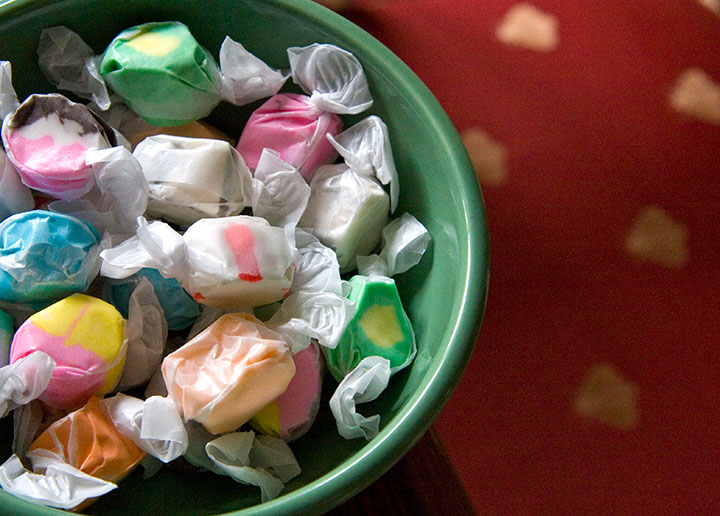
Splurging on a giant bag of salt water taffy is probably a weird way to research a new project, but I swear it’s relevant.
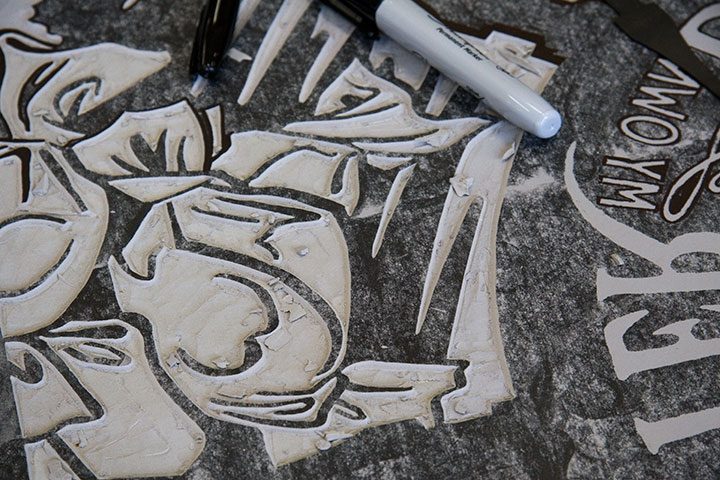
That’s right—Jessica and I are carving again. We’ve been invited by the good folks at the San Francisco Center for the Book (big shout-out to the amazing Rocket!) to be among the featured artist at their eighth-annual Roadworks festival this weekend! Needless to say, we’re super excited.
So if you’re in the Bay Area, swing on by the Potrero and check it out—it promises to be a real hootenanny. The party will be taking up a whole block, chock full of artist vendors, food carts, letterpress demos, and, of course, steamroller printing! And since these guys are rumored to be the original, no-kidding inventors of steamroller printing, they’ll show you how it’s done, for real. Here’s the scoop:
Roadworks 2011
Saturday, September 24
12 to 5 pm, Free!
Hosted by the San Francisco Center for the Book
Rhode Island Street, between 16th and 17th Streets
San Francisco, CA
As a bonus, stick around afterward for a gallery reception for the steamroller prints at 6 pm. There’ll be drinks, music, and a whole lot of loopy artists covered in ink.
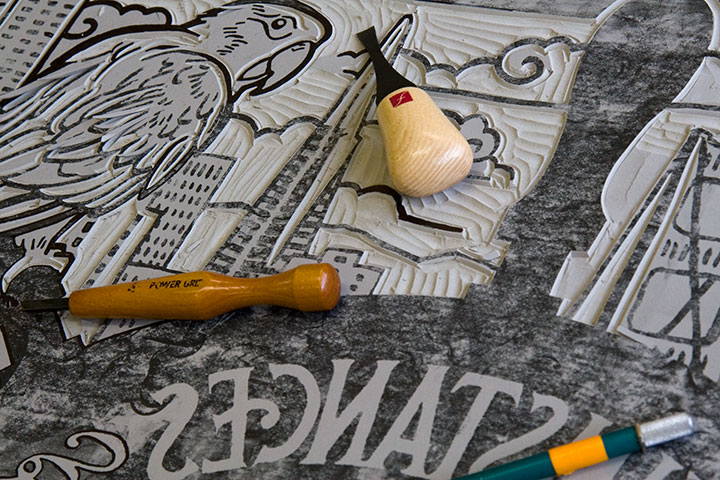
We’ve designed a brand-new, San Francisco-themed, honorary Dead Feminist for the occasion. I won’t reveal who she is until we get back, but here’s a hint: she knew her way around a fo’c’sle and a taffy pull equally well.
And of course, in honor of our muse, we’ll be sharing that salt water taffy at our table. It’s the good stuff, we promise. (Well, we had to sample it, didn’t we?)
See you in San Francisco!
September 10th, 2011
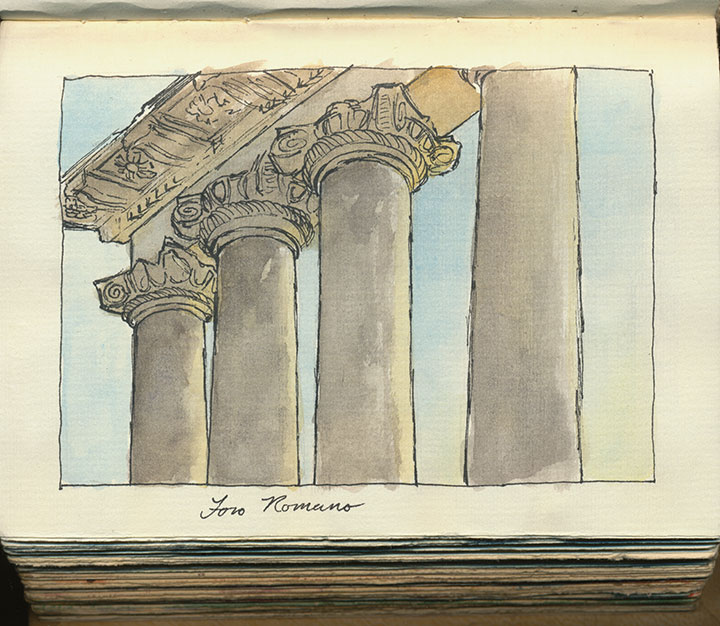
All this week the radio, the blogs, the instant media, and I’m sure the television, too, have been blaring with recaps and riffs and reflections and rage, on repeat, about that day when we all learned a little more about the nature of fear. And it’s not that I’m avoiding thinking about it—it’s that I don’t need any help from the talking heads to process my thoughts. So while I’m mindful of that terrible anniversary, there’s another, more joyful one that’s closer to my heart. You see, it was ten years ago today that I moved to Rome.
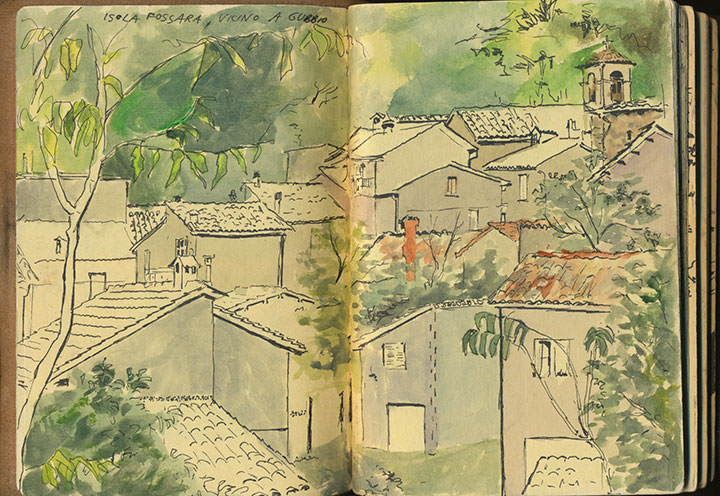
It was my third year of college, but it wasn’t your average study-abroad program. Because my school owned a (haunted!*) house in the middle of the city, and the program was based on independent study, I was able to experience true immersion in the culture and language.
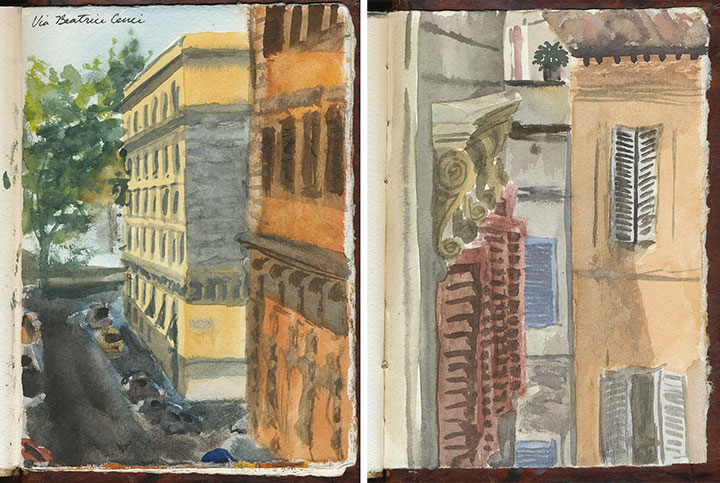
*Built c. 1590, the place was home to Beatrice Cenci, who was infamously executed for the murder of her abusive father. I’m not the superstitious type, but all I’m sayin’ is … well, weird stuff happened in there.
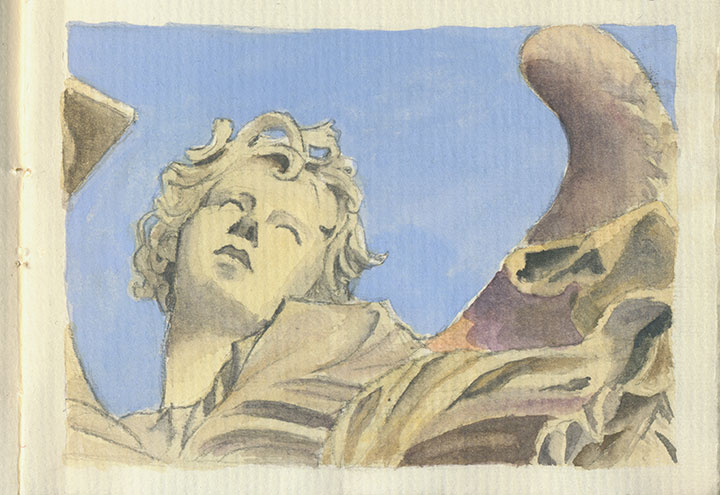
Even at the time, I was aware of just how dumb-lucky I was, not only to have arrived there safely from New York the day before the world turned upside-down—but to have nearly an entire year in which my only responsibility was to experience and absorb the world around me.

That, and to get it down on paper—which proved to be the hard part.

Not that I didn’t try. With flawless weather almost year-round, it was easy to spend every waking minute outside. And with cheap, frequent trains bound for nearly every town in the country, I had no shortage of freedom to roam (sorry). But I’m the obsessive type. I needed to see everything, and though I knew how impossible that was, I think I came about as close as any one person can do. And I have hundreds of drawings as testament to that.
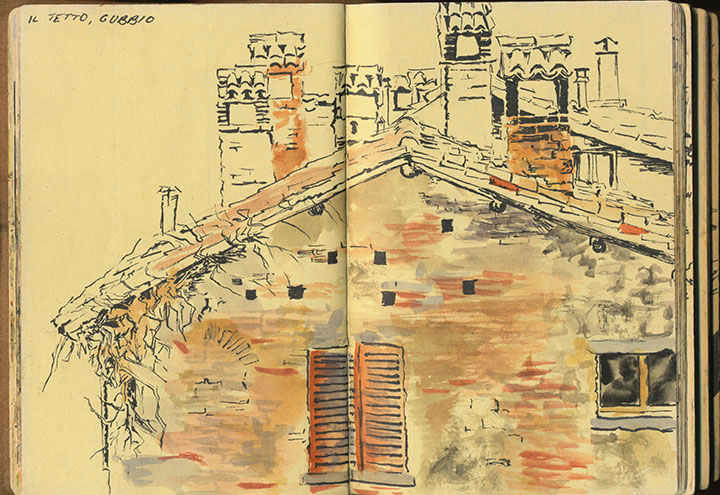
The drive to make the most of my time there was maddening, in the best possible way.
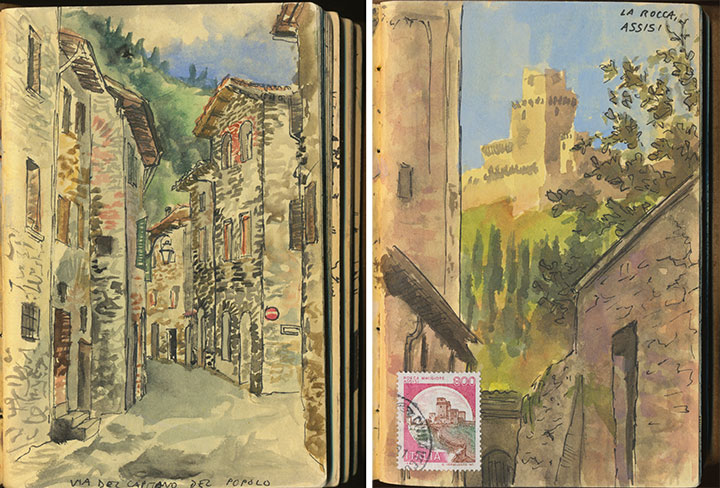
I didn’t know when or if I’d ever have an opportunity like this again, so I did my level best to commit as much of the place to memory as I could. For once, the camera went into storage (I think I shot a grand total of about three rolls of film—remember film?—in ten months), and I left the maps at home. I stuck to paint-and-paper, and my own two feet—and as a result, my memories and mental map of the place are still the clearest, the most vivid of any other place or time in my life.
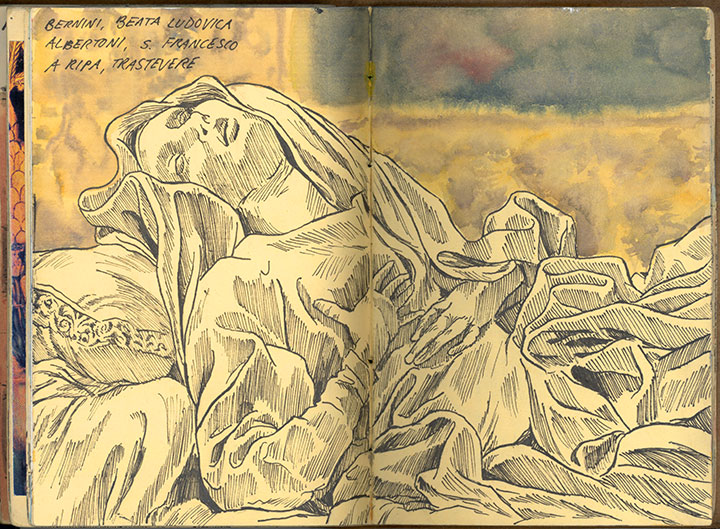
Needless to say, it was awfully hard to leave. Instead of going home, it felt like I was leaving it. And when I arrived back in the States, thanks to the tragedy that took place the day after I left, everything had changed.
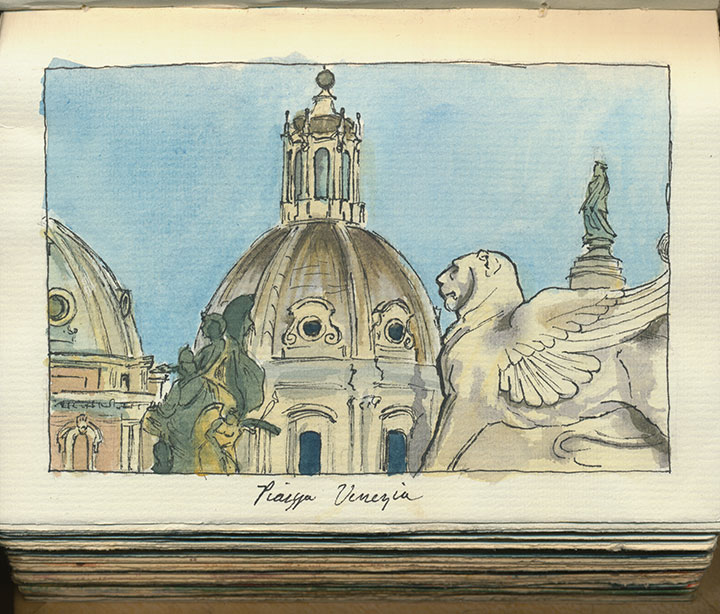
But then again, so had I. And that made all the difference.

August 11th, 2011
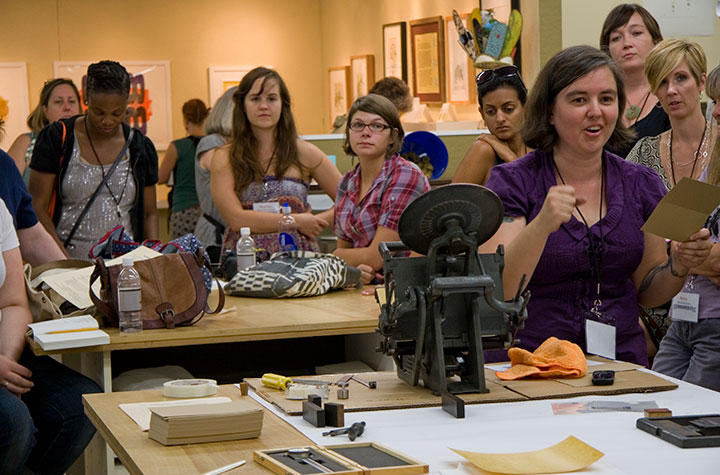
Virginia Woolf said that “a room of one’s own” was essential for women to do creative work—so imagine what 150 women could do with such a room. Jessica and I got to unveil our newest broadside at the first-ever Ladies of Letterpress Conference in Asheville, NC, where we were asked to speak about our series. It was unbelievably inspiring to stand in a room full of heavy equipment—
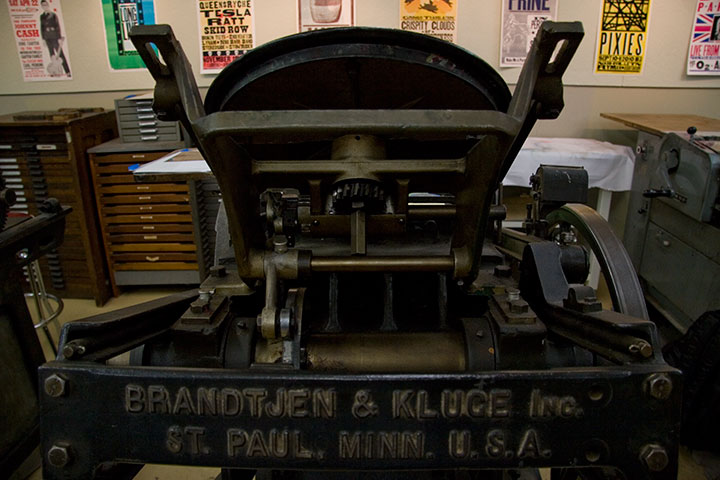
and even more exciting to help our fellow lady printers turn that room into a powerhouse. The conference was a smashing success, and we were both surprised and heartened to discover just how many of us are out there.

The three days of LofLCon were jam-packed with panel discussions, demos and presentations with the most prominent and skilled members of the letterpress community;

an exhibition to introduce us to a vast array of talent;

and a whole lot of hard-won know-how—like when to salvage an old press, and when to hold a funeral. (Sigh.)
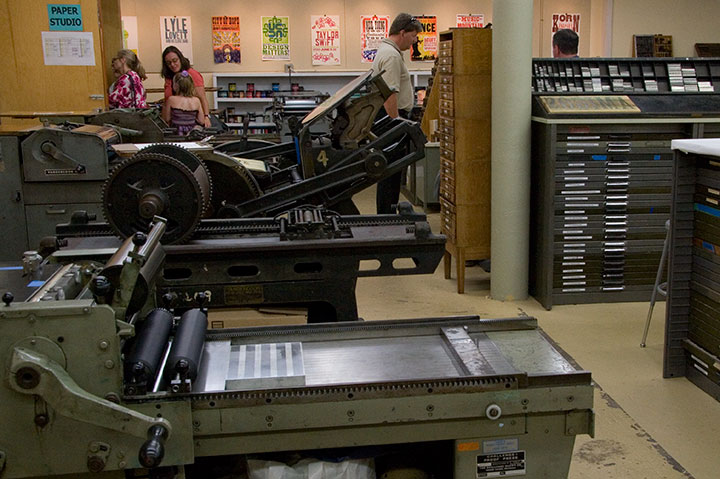
Absorbing letterpress goodness by osmosis was wonderful—
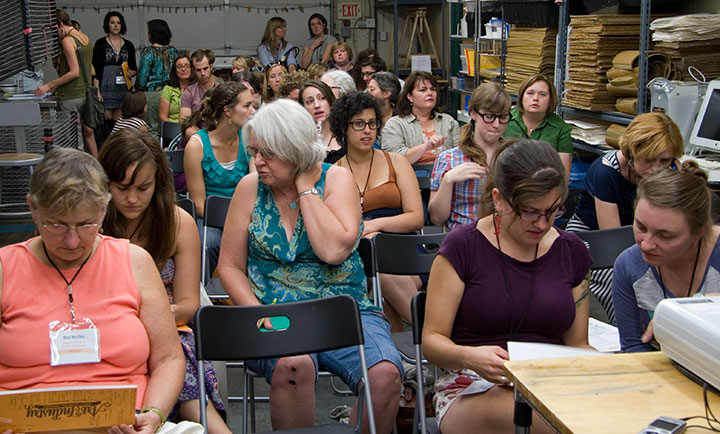
—but the best part was meeting dozens of long-admired artists and brand-new, fresh faces alike.
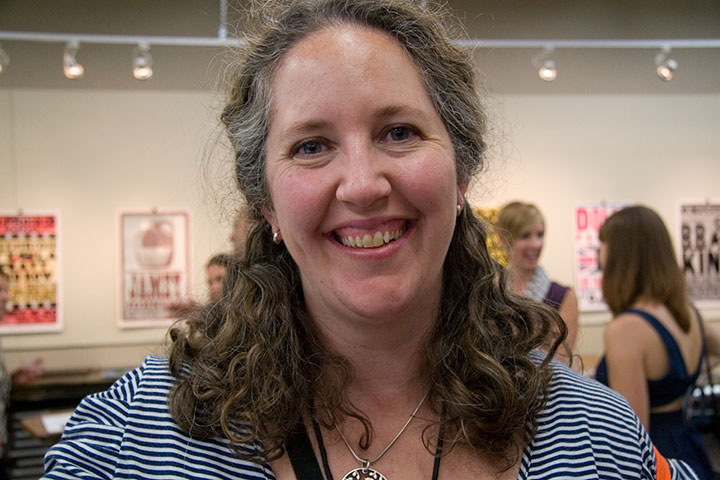
And then there was the joy of running into old friends—look who it is! It’s the lovely Allison from Igloo Letterpress, one of my favorite partners in crime!
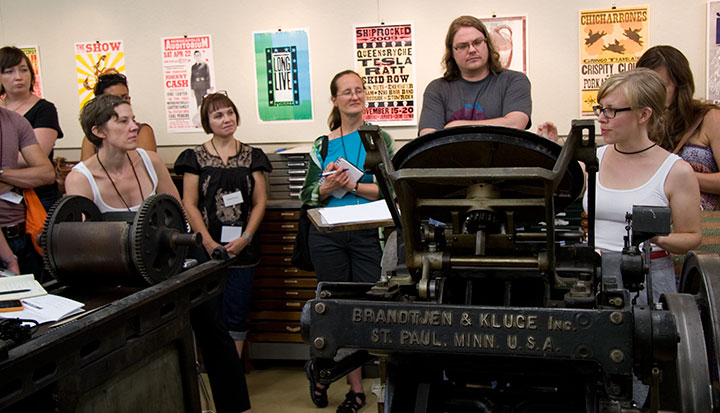
I can’t express enough how excellent the weekend was—Jessica White and Kseniya Thomas (pictured here in white, giving a die-cutting demo on the platen press) deserve a standing ovation for organizing such a fabulous event, and wrangling so many printers to make it happen.
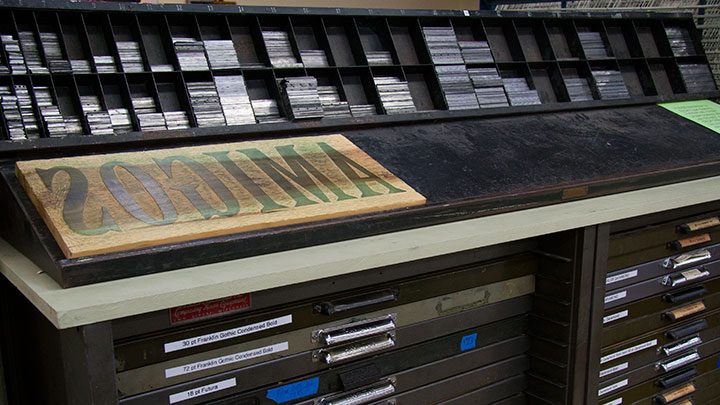
And for those hundred-plus people who shoehorned themselves into that tiny space to attend our Dead Feminists talk, we can’t thank you enough. Your support and enthusiasm for what we do was completely overwhelming—and it was so much fun to be able to get technical with y’all! (Sorry, the accent rubbed off a bit.)
One more thing: I know it somehow didn’t come across in my photos, but we were blown away by the sheer number of feminist fellas who came out of the woodwork and outed themselves as fans of the series. We love you guys—you make us feel like we must be doin’ something right. And thanks to the conference, we’re fired up and ready to get back to work.
April 19th, 2011
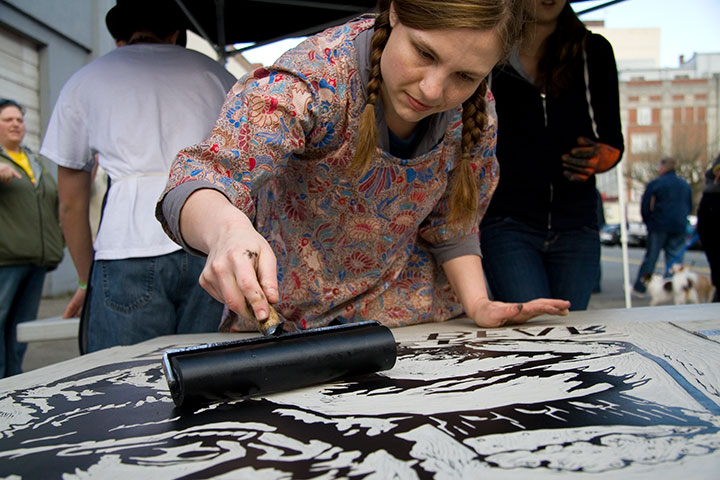
Holy flying gaggles, but we upped the ante this year!
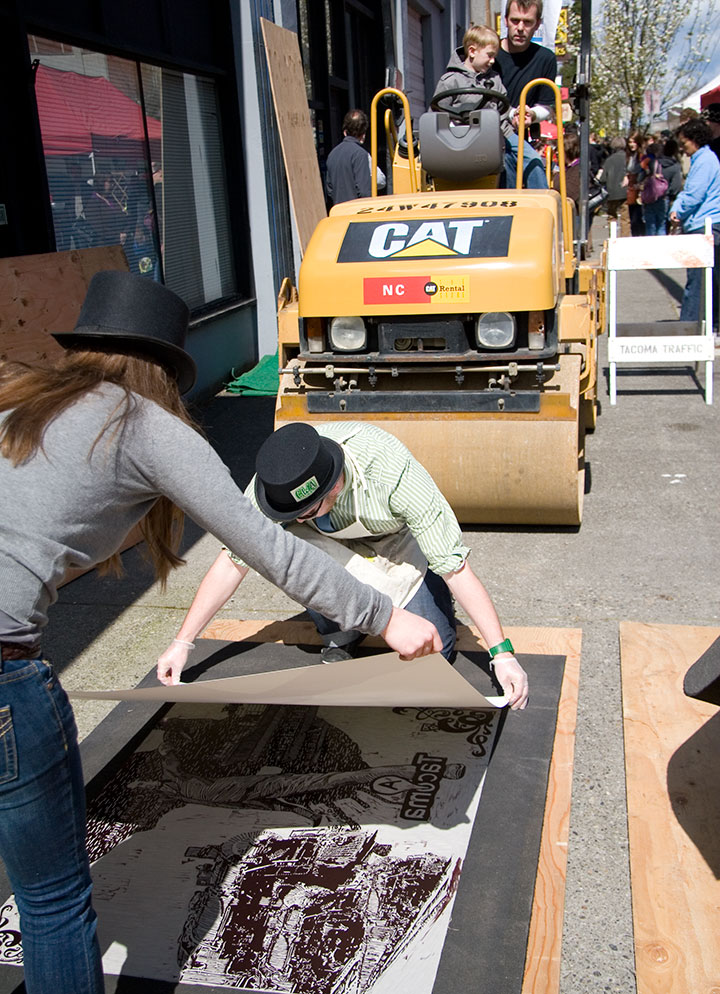
I don’t know if it was the gorgeous sunshine that graced us after literally months of dreary rain—

—or Sweet Pea’s extra-awesome 2011 poncho—
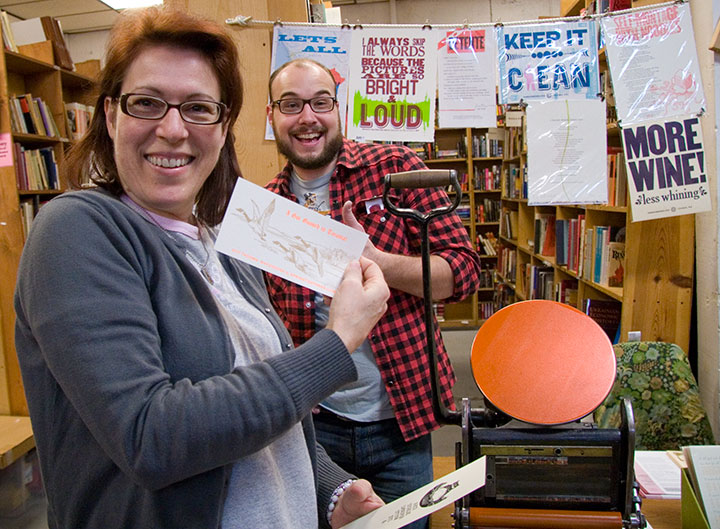
but this year’s Wayzgoose was larger than life.
(In case you’re curious, that little Sigwalt press is inked up to print “I got goosed in Tacoma!” in an eye-frying safety orange that would make any Ducks Geese Unlimited hunter proud. I mean, come on—we have standards. This is some high-brow entertainment here.)
Anyway, speaking of geese…

Ta-daaaa!
As you can see, we took our little Dead Feminists theme somewhat loosely this time. And in fact, we’ve dubbed our print Lucy Goosey, so there! There is a bit of a story behind this one, though. We’ve been equal parts amused and annoyed by the recent crafty and pop-cultural trends involving moustaches and putting birds on things—and for months I’ve been threatening to put a moustache on a bird on something, just to prove a point. I don’t know what that point is, exactly, but I figured it was time to put my moustache where my mouth is.
Which reminds me:
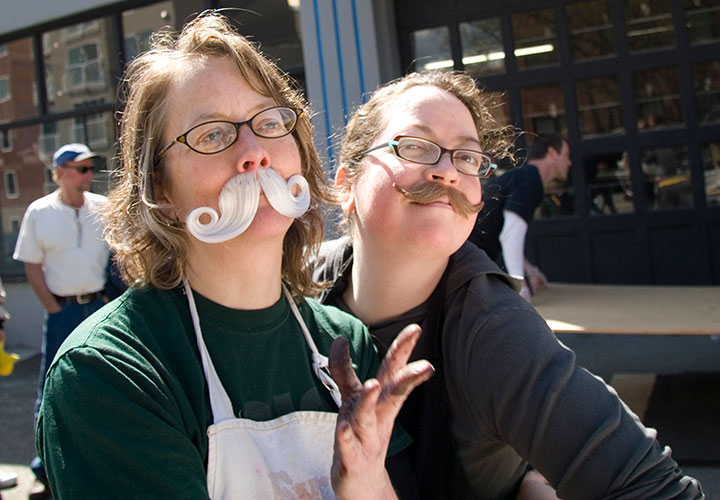
we weren’t kidding about the ‘stache wax. Hey, if you’re going to go, go all out.
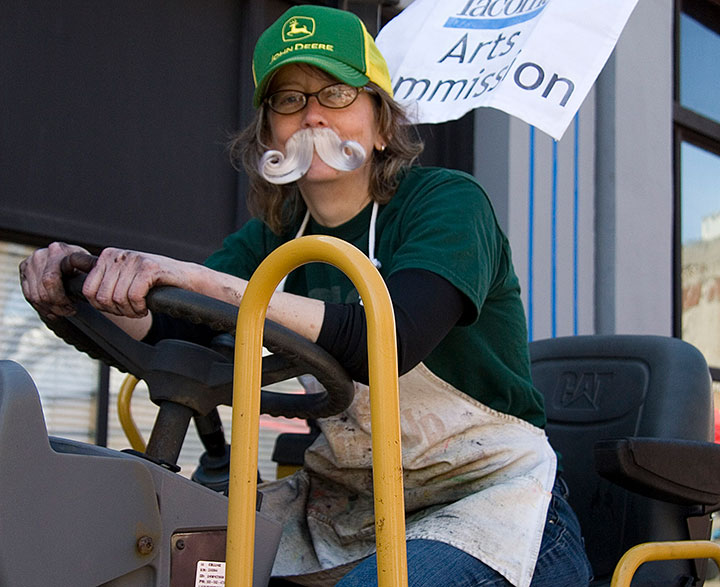
Jessica seemed perfectly at home while operating heavy machinery and sporting a full-on Wilford Brimley look—
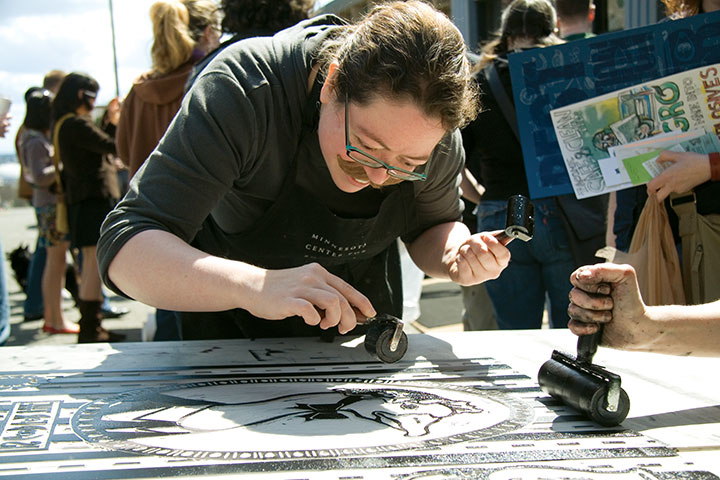
I mostly just looked like Ned Flanders. Good God, but that mustache looks real on me. Sheesh!
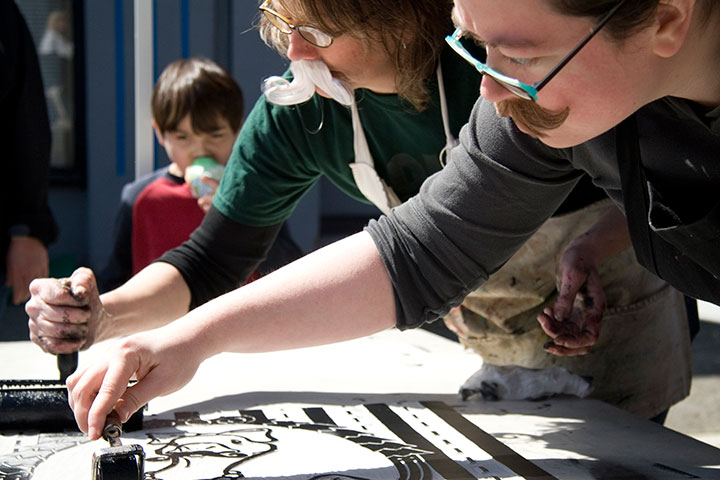
That’s okay, though—synchronized inking is serious business, and we don’t mess around.
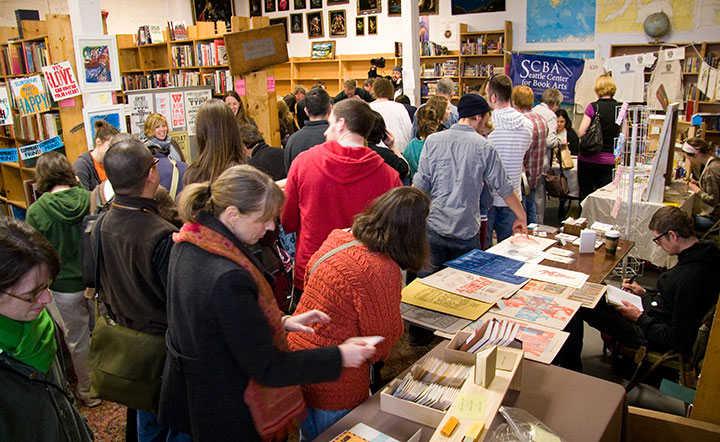
Many, many thanks to all the supporters, enthusiasts and volunteers who turned out in droves;

to Katy Meegan and Mary Holste for snapping ‘stache shots for us;

to King’s for being the host with the most;
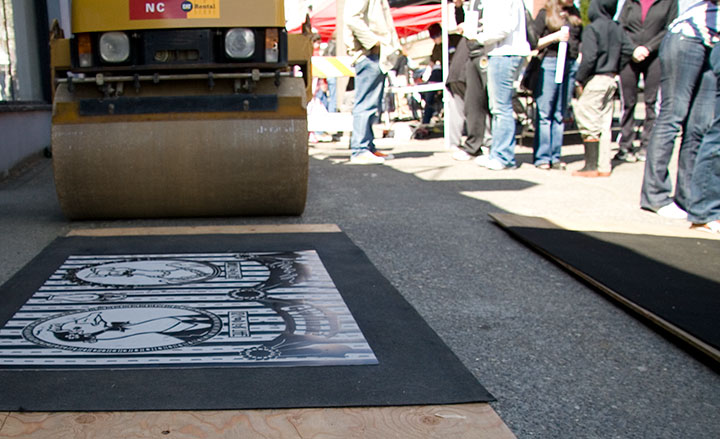
and to the Tacoma Arts Commission for sponsoring our steamroller shenanigans.
So … tell me.
Is it too soon to start cookin’ up next year’s ‘goose?
April 12th, 2011

Jessica and I have locked ourselves in her studio with an armful of Talking Heads records (go, portable turntable!) and some very sharp knives. Don’t worry about us, though—it’s just an annual tradition here in T-town.
That’s because this Sunday is the seventh annual Wayzgoose, that crazy letterpress block party that draws hordes, flocks, gaggles of people to King’s Books for some seriously huge fun. And we’ll be polishing up our street cred with the main event—steamroller printing. We’ll be pounding that pavement come rain or shine (please, pray for shine), so stop by and check it out!
7th Annual Wayzgoose
Sunday, April 17, 2011
11 am to 4 pm, Free!
King’s Books
218 St. Helens Ave., Tacoma, WA
Near the top of a very long list of things I love about Tacoma is the sheer number of people here who know what the heck a Wayzgoose is. If you haven’t experienced ours yet for yourself, you’re in for a treat. Meet a whole host of local and regional artists; shop a huge array of letterpress art and gifts; make your own books and posters; and don’t forget to bring a t-shirt! The D.I.Y. screen printing booth will back by popular demand, and this year, some of the street-printing artists (including yours truly) are going to have bite-sized versions of their steamroller designs ready to be made into t-shirts. I know what I’ll be wearing this weekend.
Speaking of which … Jessica and I don’t want to ruin the surprise, so we’re keeping our design under wraps for now. But let’s just say that this year we’ll be getting our feathers ruffled—
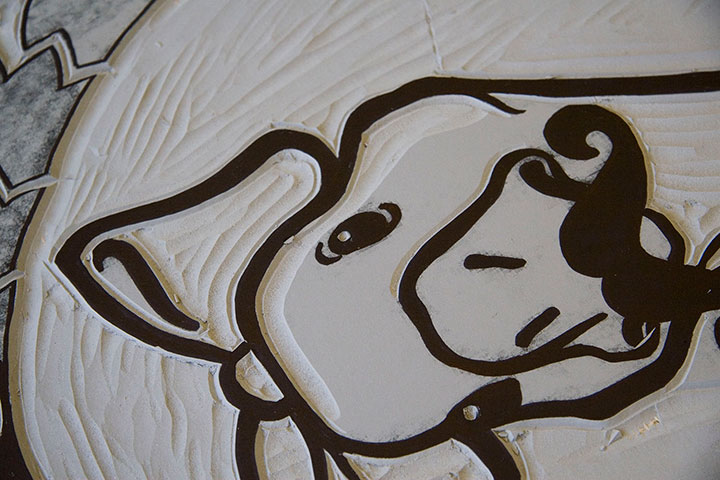
—and breaking out the ‘stache wax.
See you Sunday!
March 5th, 2011
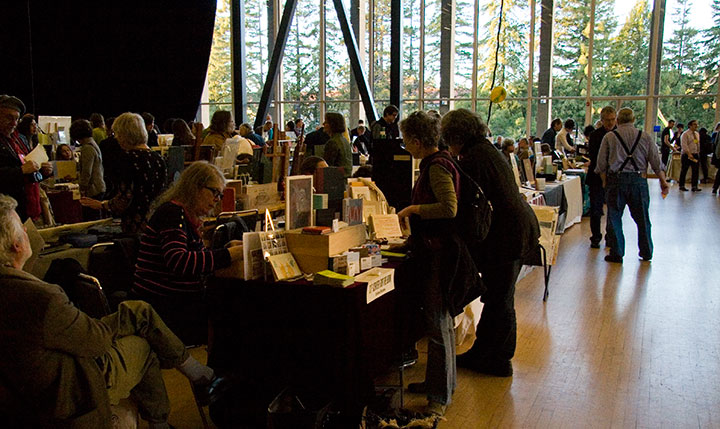
You know, I spent the whole time I was at Codex just trying to process everything around me. I thought the few weeks since that I’ve been telling stories and rehashing memories would make it easier to sort it out in my mind, but I still just can’t seem to articulate the impressions bouncing around the inside of my skull.
It was just too big … too rich … too much.
Which probably explains why I never managed to get any decent photos. I was too busy standing there goggling at the enormity of it all to document the experience properly. It was all I could do just to man my own table and keep track of all the folks who stopped by to talk to me.

Let me backtrack a bit, and explain what all of this was about. For every discipline, subculture or interest group out there, there’s some sort of club, or society, or conference, or symposium, or bee, or knitting night, or comicon, or hot-dog-eating contest, or what-have-you—some organized gathering for like-minded people to get together and share what they do. If you can think of it, there’s probably a group of people meeting about it somewhere.
The trouble with the book arts is that our world is small and spread out. There aren’t too many of us who do this sort of thing in the first place, at least when compared to photographers, or children’s book writers, or web developers. And then within our little group, everybody follows such a different path that getting us together is like herding cats. We’re hard to pin down because there’s a whole universe in our little speck of dust. Printing, bookbinding, papermaking and typesetting are just the tip of the iceberg. Within each of those disciplines is an incredibly broad spectrum of different and often contradictory artists and art forms. And yet each of those fits comfortably, easily, infinitely under the same, paradoxically small umbrella of the book arts. (Now you know why I’m not great at elevator speeches.) If you tried to graph it out, you’d end up with either the world’s best or worst Venn Diagram—I can’t decide.
So because we run such a crazy gamut, we can’t be shoehorned in neatly with some other event, even though the “average” book artist can and probably does moonlight quite easily as a dozen other things. There’s no “book arts corner” at SXSW, or BlogHer, or the Venice Biennale. Exhibitions and summits dedicated entirely to the book arts are few and far between—large international events are rare, indeed. So for our lot, Codex is a big deal.
This year there were over 140 exhibitors at the book fair, representing artists in every conceivable discipline and style, and every corner of the globe. The exhibitors hailed from 20 states and over a dozen countries outside the U.S., including Russia, Germany, France, Israel, Colombia, Japan, Mexico and Canada.
And it isn’t just for artists: students, educators, private collectors, librarians, museum curators, conservators and archivists, hobbyists, publishers, supply vendors, gallery reps and dealers, bookstore owners, clubs and organizations, and every stripe of enthusiast were in attendance.
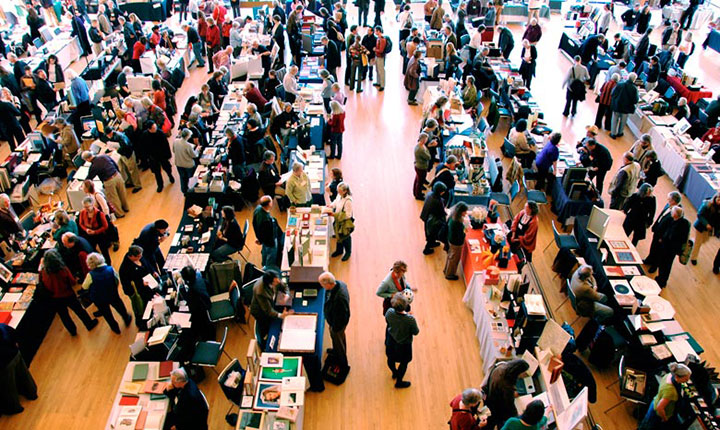
Photo courtesy of the Codex Foundation.
So yeah. Codex is huge.
It was both intimidating and inspiring. I was immediately and constantly confronted with my own insignificance (I kept imagining that at any moment, some cartoon alarm would go off—woop! woop! woop!—alerting everyone to the fact that I didn’t belong there)—yet at the same time, everyone I met was warm and welcoming.
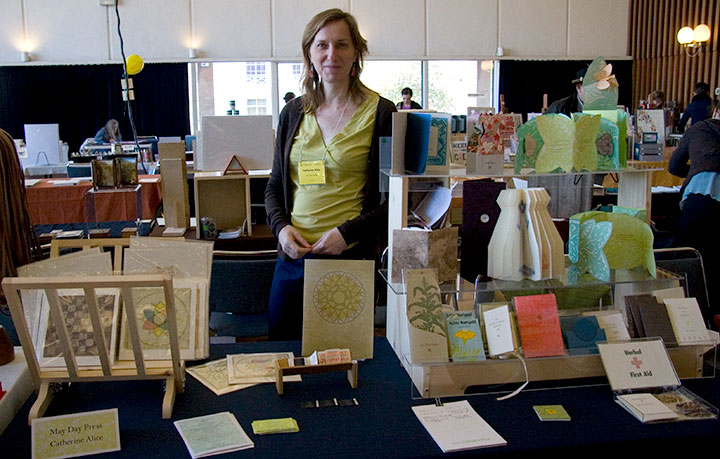
I had the chance to catch up with old friends, meet many of my long-admired art-heroes, and be introduced to a whole host of new faces.
But most of all, Codex was completely, utterly overwhelming. I had my brain cranked up into overdrive for four solid days. After meeting literally hundreds of people, answering thousands of questions, asking another thousand myself, handling many dozens of handmade books and artworks, absorbing new information and taking copious notes, and just being exposed to the ultimate sensory overload of it all—well, by the end, I was a deer in the headlights.
And I feel like I barely scratched the surface of what was there. Imagine that you’re visiting the Louvre, or the Smithsonian, or some other enormous museum. Only instead of picking and choosing which galleries and pieces to see, and making your way through room by room, you discover that every painting, every sculpture, every piece of art in the whole place is crammed into one huge hall—each with the artist who made it standing to the side, waiting to meet you and hear what you think. I’d go mad—I think I did go mad!
Everything I saw was phenomenal—it was hard not to just stand there, slack-jawed, struck dumb by the realization that there I was, in close proximity to some of the best work being done by anyone, anywhere.
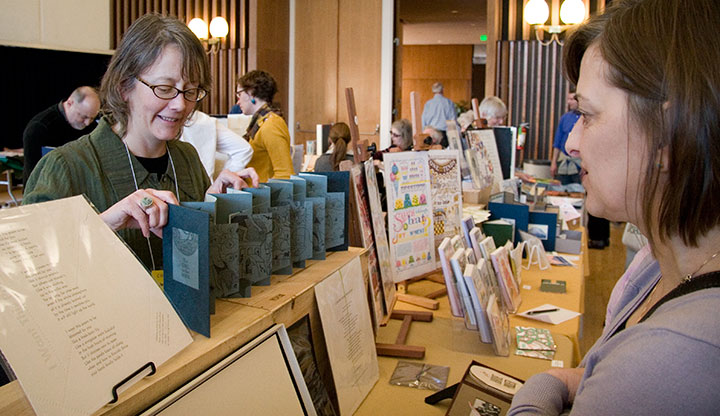
I could go on and on. And I’m sure there were a thousand other great things I never had a chance to see, because I also had a table to man. Jessica and I made the trip together (that’s her showing one of her books), and as we had adjacent tables—
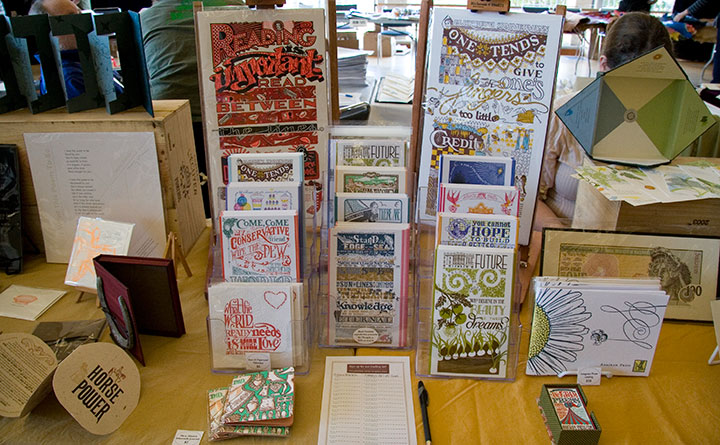
—we met in the middle with our Dead Feminists stuff between us.
Jessica’s done Codex once before, so she was prepared for the overwhelming onslaught of people. She suggested that we put together a letterpress-printed take-away catalog of our work so that after the fair, when everyone was just as dazed as I was, they’d have something to remember us by. (And that ended up being a great idea, and a big hit—we had tons of follow-up messages afterward, and we didn’t see anything like the catalog at the book fair.)
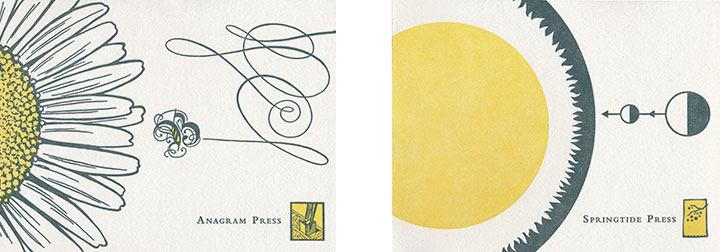
Since we collaborate on so many things, we decided to combine our efforts into one joint catalog—with a twist.
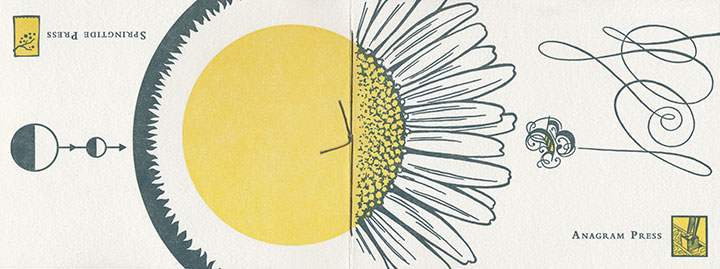
We figured we had an opportunity to clear up a little of the confusion over who does what around here, so we had fun playing with the design possibilities. Jessica came up with a flip-flop format, and I designed two covers that would come together at the spine to form a single image if laid flat.
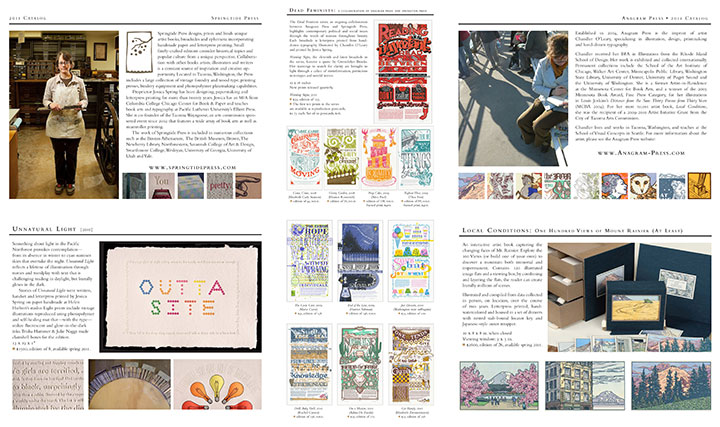
Held one way, you’d read her half of the catalog; flip it over and read from the back, and it becomes my half. We converged in the middle with a Dead Feminist “centerfold” (ha!).

For my part, the most gratifying part of Codex was watching a steady crowd playing with Local Conditions. The response people had to the book was both intensely gratifying and humbling—and it was wonderful to see that students, fellow artists, dealers, curators, professors and collectors were equally excited about it. But my favorite bit was being a bystander to all the different scenes people designed with the image flats.
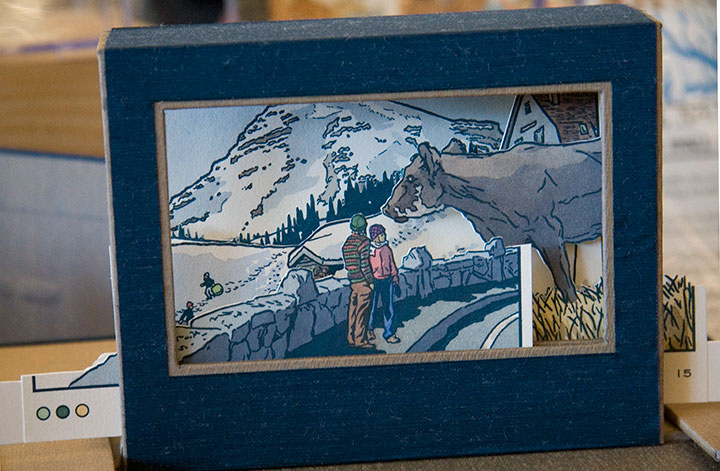
The cow completely stole the show there. It was hilarious to see how many times it turned up in a scene, either a fitting addition I hadn’t thought of—or as an absurdly out-of-place monster.
(Best of all was the cow that stood on the airplane wing and pretended to be a gremlin.)
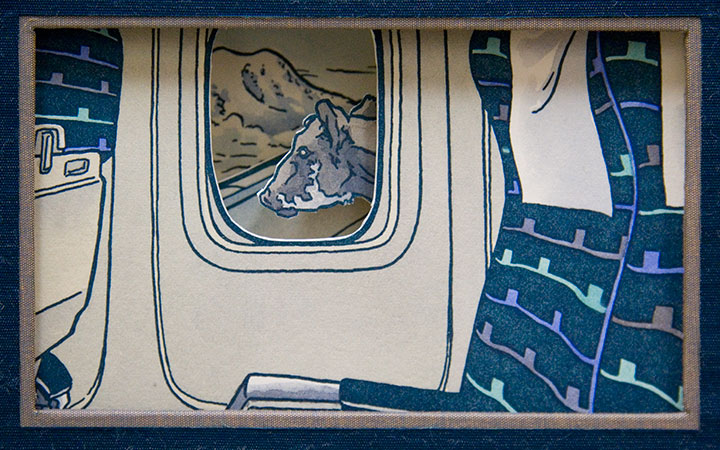
It’s hard to remember that we were in a city as fabulous as Berkeley—the folks at Codex had created a complete world just in that one room. (Though we did get out enough to discover that when the overstimulation had us in a daze, a hot-cookie ice cream sandwich down the street was just the ticket. Thank you, Berkeley!) The next fair is two years away, but I came home with what seemed like a decade’s worth of inspiration. And I find I’m already looking forward to Codex 2013—sensory overload and all.
Bring it on. I’ll be there.
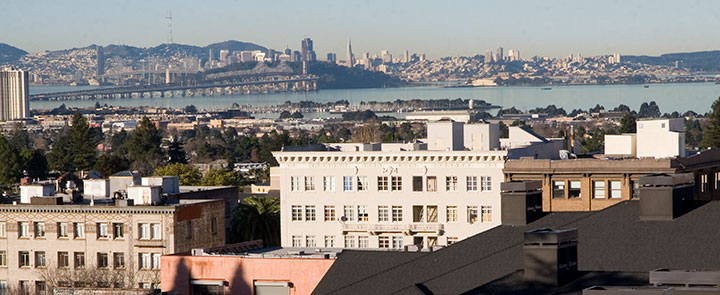
February 11th, 2011

Going A.W.O.L. from the studio can be a very good thing—especially when this is the destination.

I’m here to spend some time with these folks,
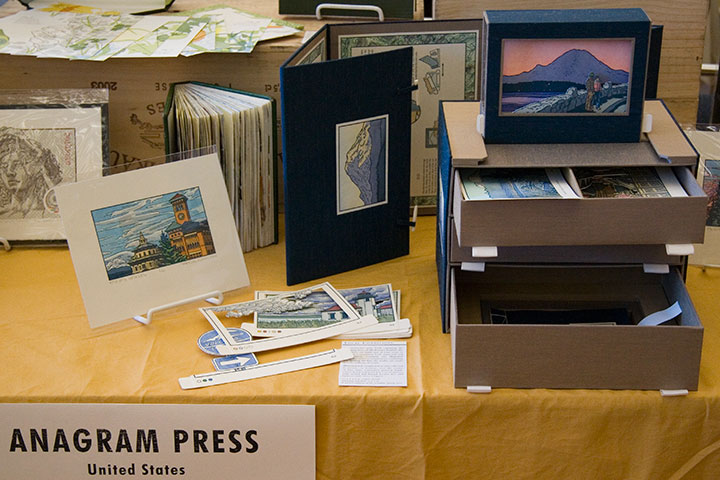
for the sake of this.
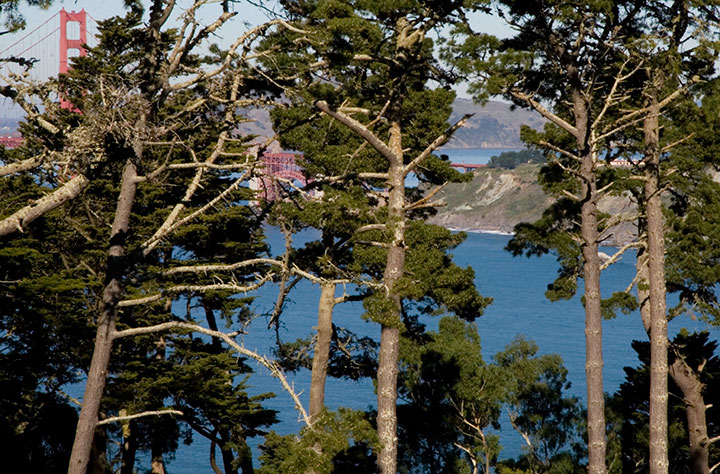
But the “work” part of my trip is done now, so I spent today up here.
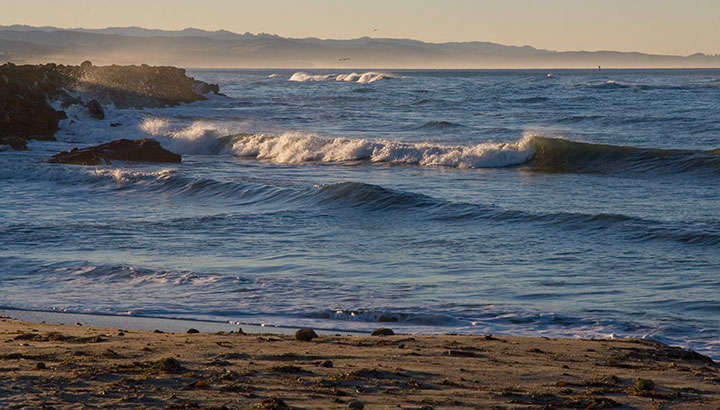
And tomorrow I’m leaving for home, but I’ll be taking the long road, by way of this.
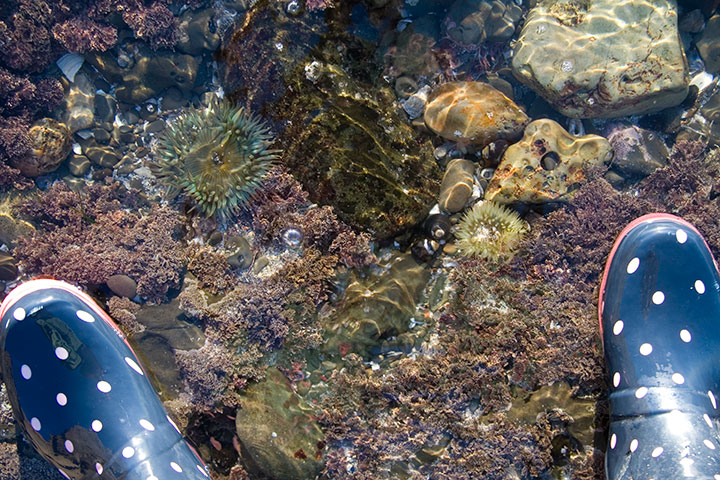
The goal is to take as much time as possible for things like these,
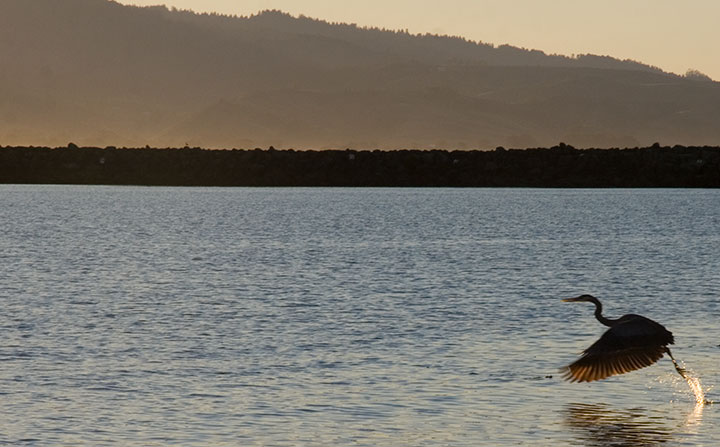
and for moments like this.
I promise to share when I get home and have access to a computer again. See you on the other end of the trail.
February 2nd, 2011
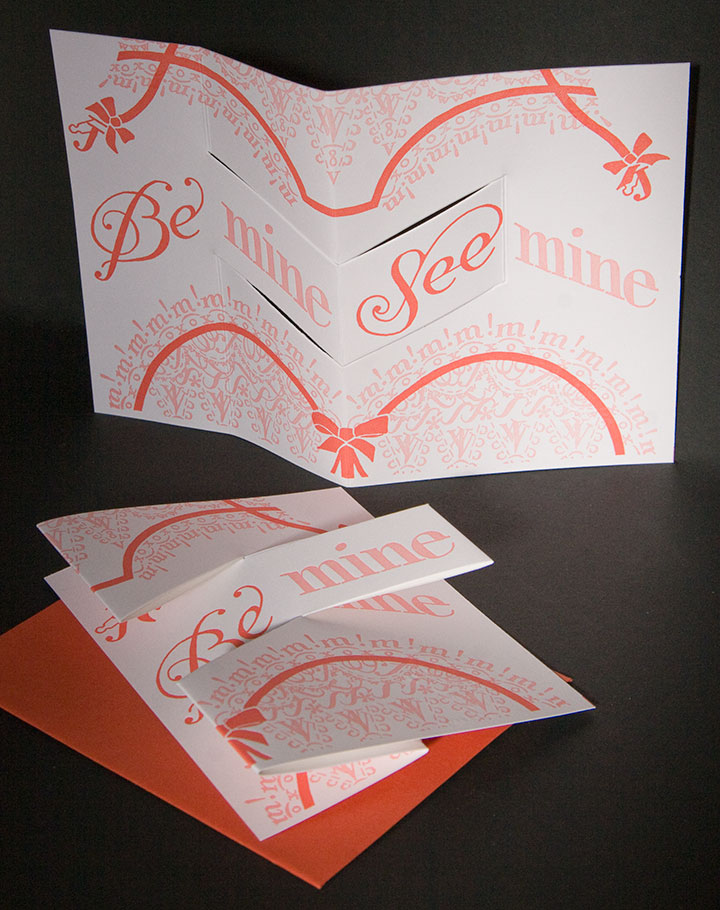
I’m giggling like a schoolgirl, now that my new Naughty Undies valentine is here! This is my latest pop-up card collaboration with Igloo Letterpress—Allison came up with with the mischievous rhyme and die-cut structure, and I did an entirely typographic illustration of a pair of pink unmentionables. Want to make your Valentine’s eyes pop a little? You can pick up your card in the shop!
January 20th, 2011
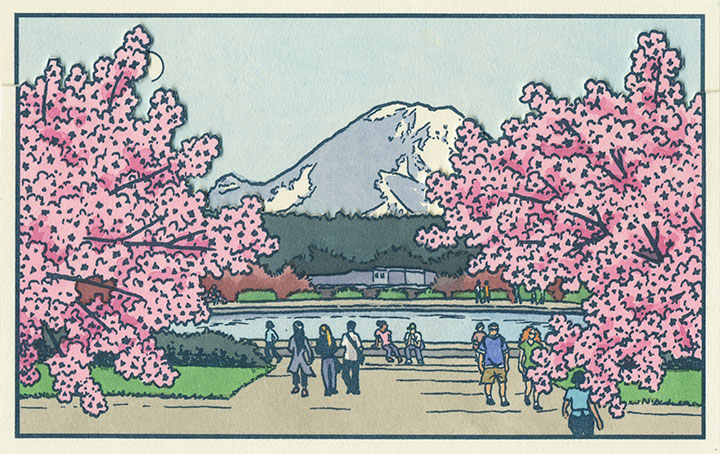
A composite of two image flats from the book.
Anyway, after a good, long run, my Local Conditions exhibit is closing tomorrow afternoon, and this week I’ve been revisiting some of my favorite images from the book. This one always gets me thinking about how much a city can change over the course of a century, and how for a newcomer like me, that change isn’t always apparent. There aren’t always little plaques or signposts to tell you what used to exist where you’re standing now—or even any evidence at all of how things used to be.
This scene depicts the Drumheller Fountain (also known as Frosh Pond), located on the University of Washington campus in Seattle. Incidentally, on my first trip to the Northwest almost exactly four years ago, I was standing on this very spot when I saw Mt. Rainier for the first time. This is where the idea for the book first struck me—although at the time it was a very different, and much simpler concept. And at that moment, I had no idea that the view itself had a history all its own.
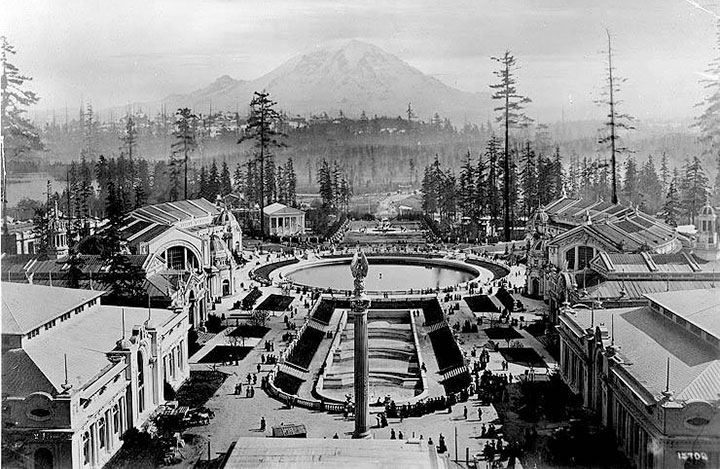
AYP and Camp Harmony images courtesy of the University of Washington Library
This is Frosh Pond in 1909, when it was called Geyser Basin (part of the so-called “Arctic Circle”), and when it was not a part of campus, but the centerpiece of the University’s predecessor, the Alaska-Yukon-Pacific Exposition.
An event similar to a World’s Fair, the A-Y-P showcased the natural and economic resources of the Pacific Northwest with pomp and splendor. To mirror the purpose of the exposition, the fairgrounds (designed by the famous Olmsted Brothers) brought the region’s greatest symbol into stunning focus. This so-called “Rainier Vista,” culminating in the Arctic Circle, helped draw in 3.7 million visitors over the fair’s four-month duration.
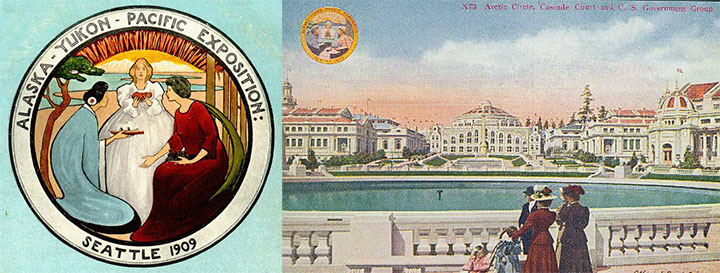
Very little evidence remains of the A-Y-P fairgrounds today (much to my chagrin); the vast majority of the fair’s buildings were temporary, and even the landscape design of the modern University has all but obscured the original layout of the A-Y-P grounds. But the Arctic Circle is still there, and when you step out from behind a row of blooming cherry trees in the spring, the Rainier Vista still hits you with full force.
Speaking of fairgrounds, closer to T-Town is another historical remnant—this time, however, instead of a long-past event with only a marker left behind to hint at what was, these fairgrounds still hold to their original purpose today.
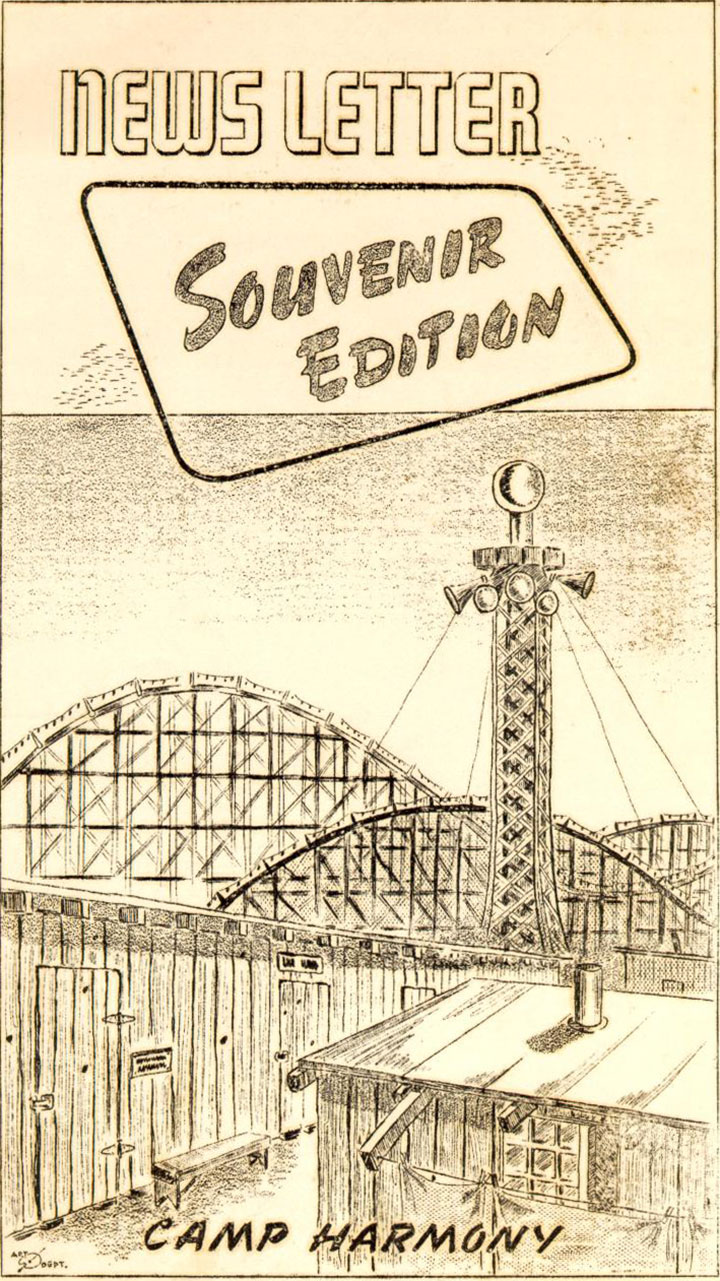
Illustration by Eddie Sato, Camp Harmony inmate and “staff” artist.
I’m talking about the Western Washington Fairgrounds in Puyallup, which are still in operation (though the event is now called the Puyallup Fair—that’s pronounced “Pew-AL-up”). In 1942, the U.S. government evicted, rounded up and imprisoned over 100,000 Japanese Americans living on the West Coast; the internment began with the forced migration of families living on Bainbridge Island, across the Sound from Seattle.
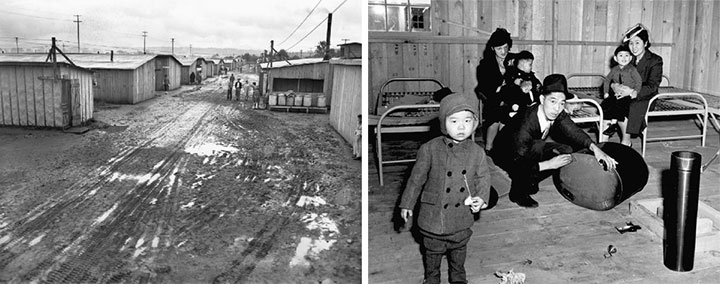
While they awaited the construction of permanent internment camps further inland, many Japanese Americans were sent to temporary “assembly centers” to coexist in cramped barracks with other families, often in substandard living conditions. Thousands of Washington’s interred residents were sent to the assembly center nicknamed “Camp Harmony,” hastily constructed on the fairgrounds in Puyallup, right alongside the fair’s permanent buildings and rides.
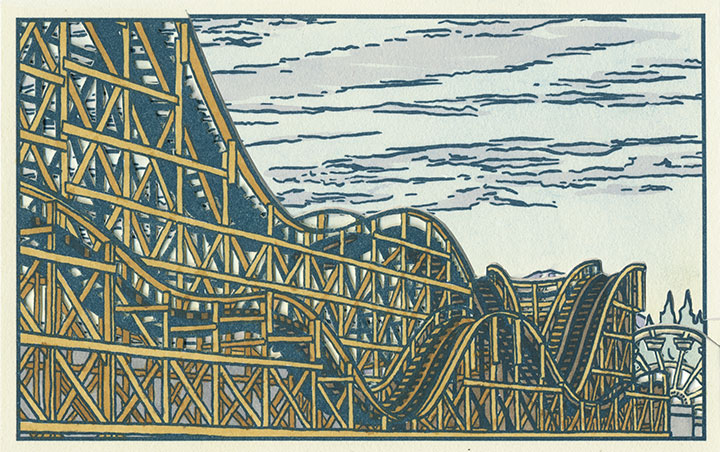
Three image flats; the mountain is almost completely hidden here.
Camp Harmony was torn down after just seven months, but the Fair continues to this day. (To my everlasting horror, the Fair’s website mentions Camp Harmony only obliquely on its “History” page—it states only that “the fairgrounds were used as a temporary shelter“—emphasis mine—during World War II. Right. A shelter where the “refugees” were imprisoned under armed guard.) And the wooden roller coaster that overshadowed Eddie Sato’s scene of the camp still stands. Now that I’ve learned the history of the place, I’ve lost my appetite for rollercoasters, funnel cakes and blue-ribbon vegetables. But the fairgrounds made for an image that dovetails eerily well with the homage to Japanese art upon which Local Conditions is founded.

Photo courtesy of Jessica Spring
And then there’s the kind of history that unfolds right before your very eyes. Remember the Luzon building?
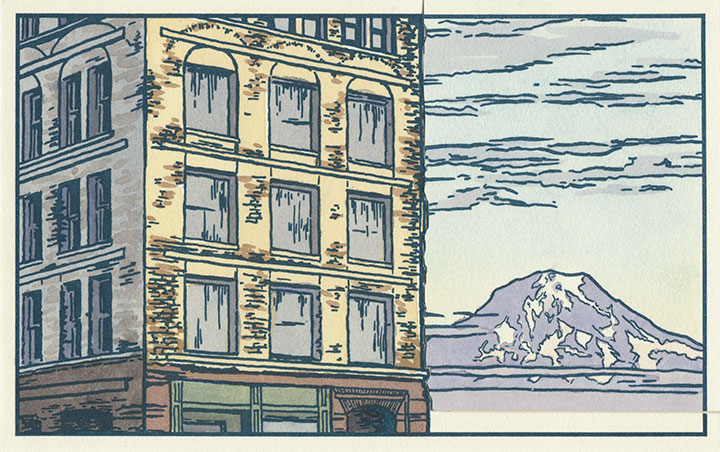
Two image flats; recognize the sky in the background?
Well, it was slated to be a part of the book from the very beginning—just by virtue of being a structure that caught my eye and that came with a good view of the mountain.
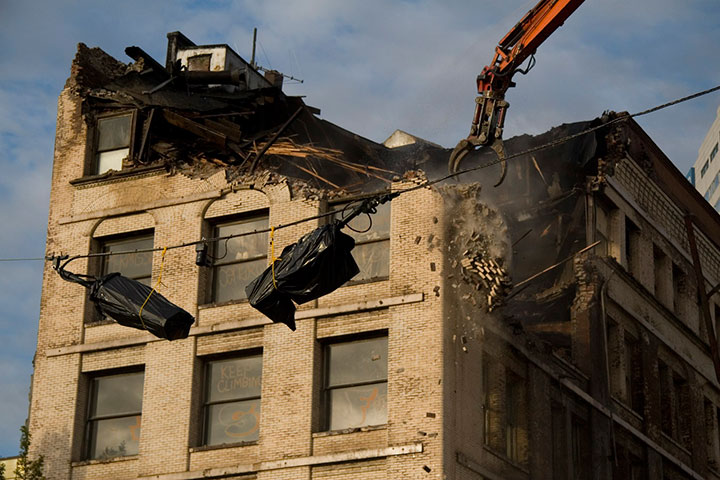
But then they knocked it down in September 2009, and suddenly I became an eye-witness, with an opportunity to document history as it happened.
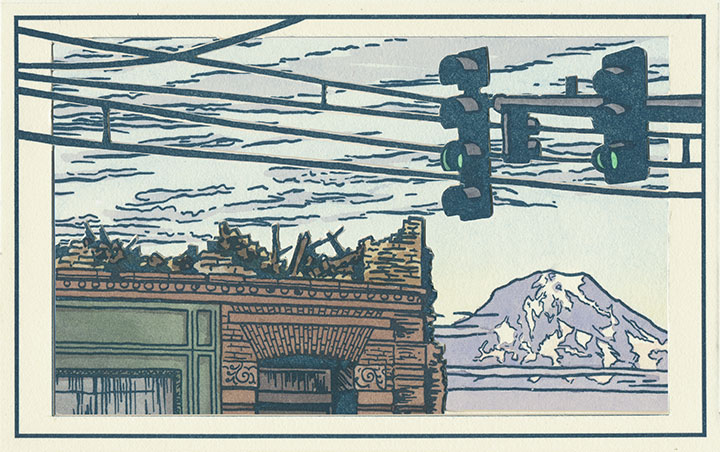
Three image flats; same mountain, drastically different view.
I wish this were an imaginary scene, but it’s moments like this that the book is all about. Now you see it, now you don’t.

Postcards circa 1910. Courtesy of the Tacoma Public Library
And to top it all off, it’s looking like Tacoma’s history is in danger of repeating itself. This is a postcard dated 1905, depicting what was an iconic view even then—the “Gateway to the City of Destiny.” The building on the left is the former Northern Pacific Railroad Office; on the right is Old City Hall.
Tacoma built a new city hall a few blocks away in the 1930s, but both the Northern Pacific building and Old City Hall still stand—the addition of a freeway the only major change to the site pictured. But on November 24, 2010, after an unusual cold snap, a pipe burst in Old City Hall—soaking the walls, ceilings and floors with 30,000 gallons of water. With extensive flood damage and the building owner entering foreclosure, the building faces an uncertain future. I only hope it doesn’t go the way of the Luzon.
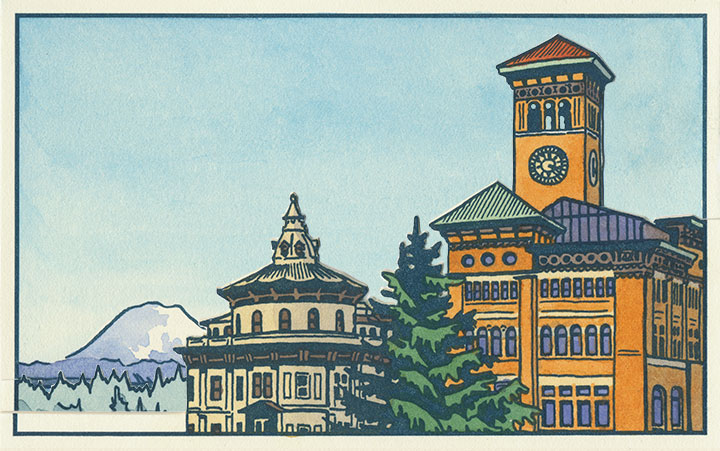
Three image flats; there’s an individual print version in the shop.
When I started this project, I had no idea of what I was getting into. I knew that I would stumble upon some pretty fascinating history, but I never would have guessed that a fountain, some fairgrounds and a pile of bricks would draw me in so completely. But now I’m hooked—and the best part is that after all this work, I no longer feel like an outsider looking in.
This is my history now, too. For better or worse, I want to see how it all plays out.
January 1st, 2011
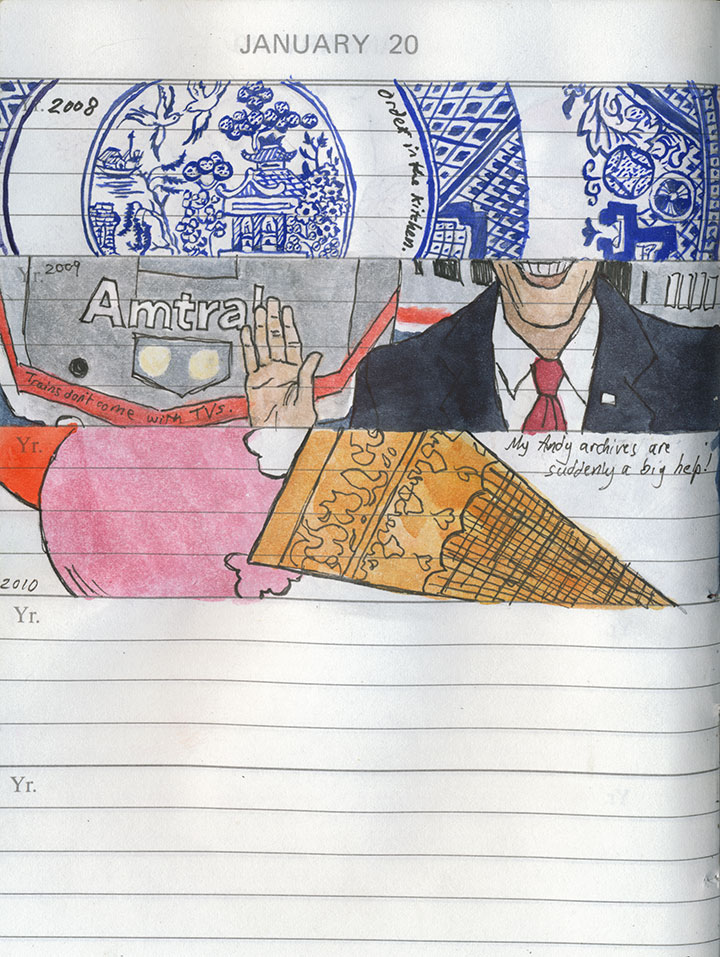
This might seem a little strange, coming from me, but the New Year’s resolution at the top of my “art” category is to draw more.

I mean that I’d like to spend more time with my sketchbooks—with everything else that happened last year, there just didn’t seem to be a spare second for observing the moment and jotting it down.
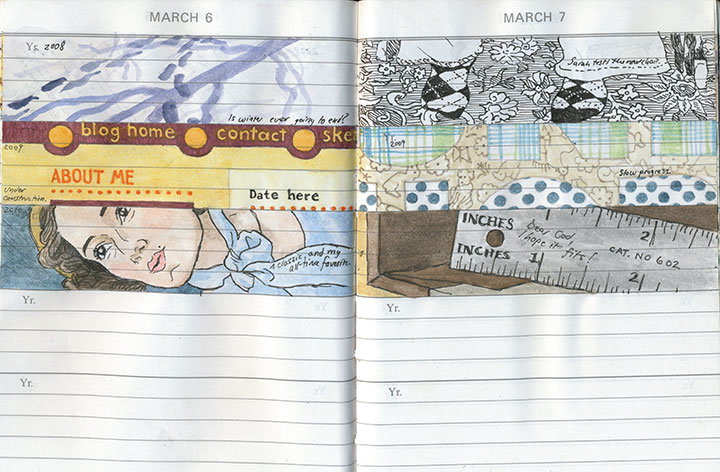
The daily book was about the only thing that received any attention, and even it spent the entire year on the back-back-back burner.

I still have quite a bit of catching up to do there, though—
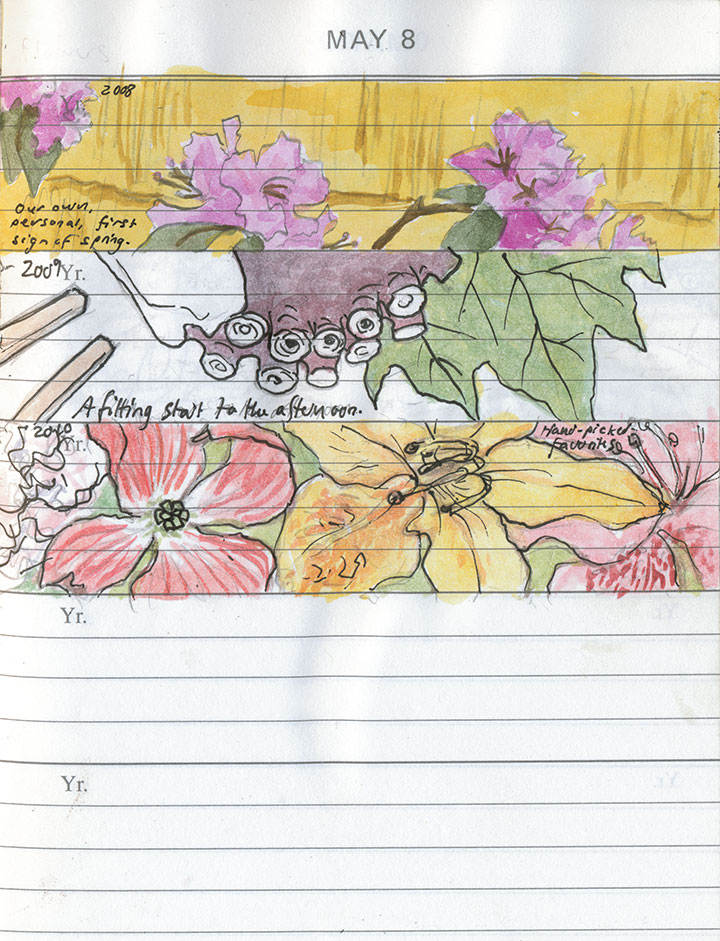
so that’s where I’m going to start.
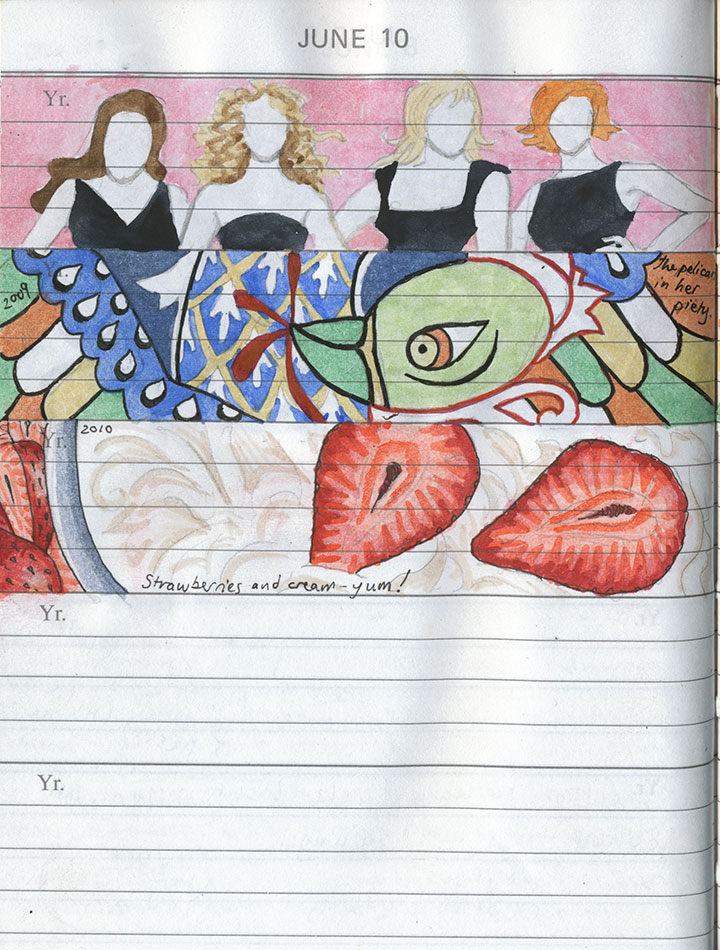
It’s a daunting prospect; even just filling in half-finished sketches (maybe I should have shown you those instead!) amounts to a huge time investment, and a mountain of work.
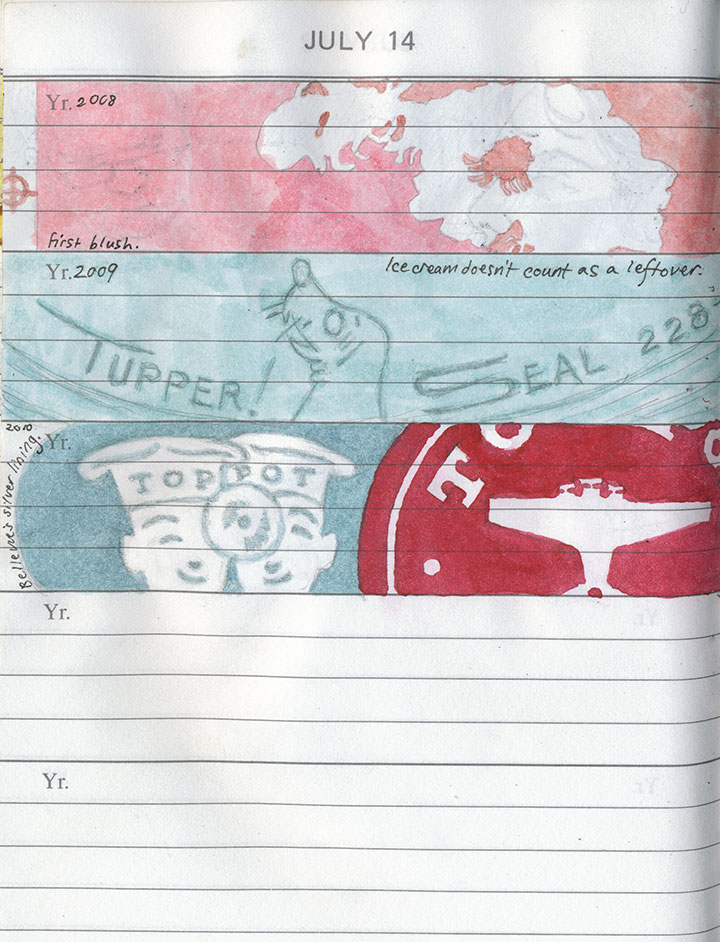
But I’ll get there. And besides, it’s those last two blank slots on every page that interest me the most.
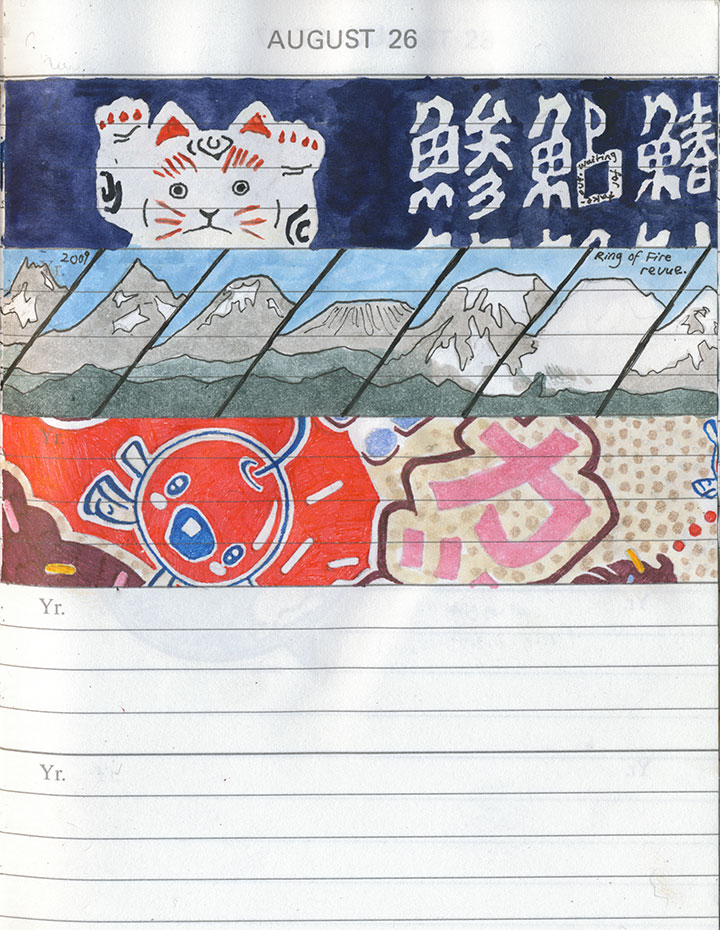
They stand for the future that’s unwritten, and I find I can’t imagine what could possibly complete the picture—nor could I ever have predicted what has ended up here thus far.
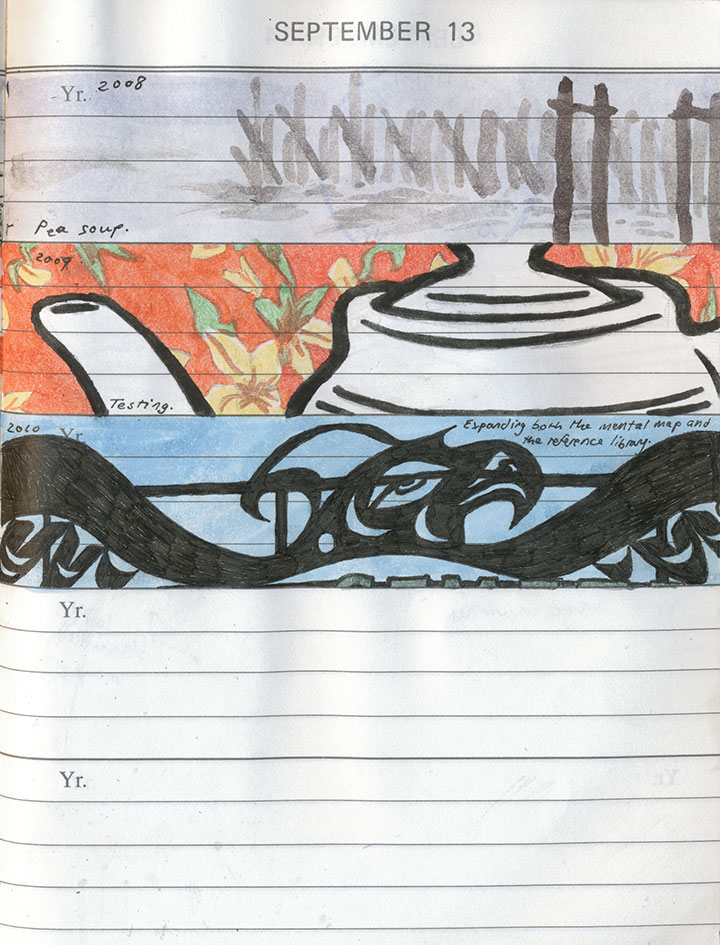
When I first started this project, it seemed like a painfully slow undertaking.

But now I’m surprised at how quickly the book is filling up,

and I’m anxious to find out what will fill out this page—and the next, and the next.
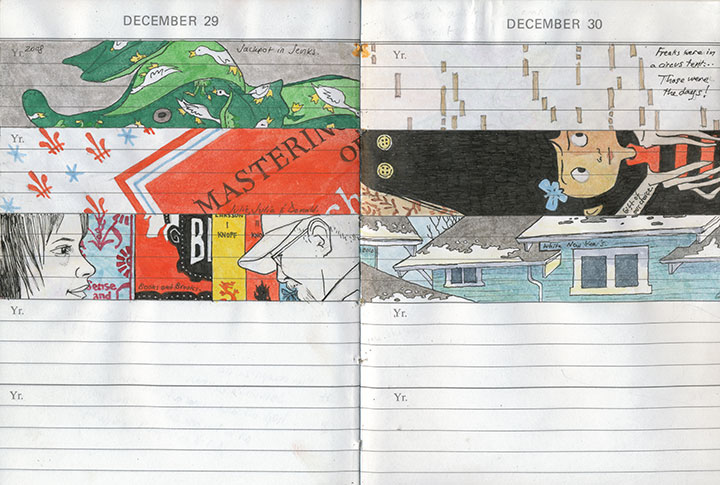
Well, today I flip the book back to the beginning, pencil in hand—and so I’ll find out soon enough.
Happy New Year!

![Chandler O'Leary [logo]](https://chandleroleary.com/wp-content/themes/chandleroleary/images/logo.png)


















































































